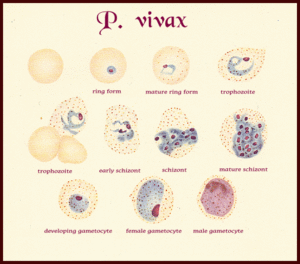Plasmodium vivax: Difference between revisions
| Line 30: | Line 30: | ||
===Appearance=== | ===Appearance=== | ||
[[File:P.-vivax-vertebrate-stages-20040603215831722.gif |thumb|right|link=https://blogs.biomedcentral.com/bugbitten/2014/07/02/malaria-can-make-you-more-attractive-to-mosquitoes/|stages of P.vivax development]] | |||
''P. vivax'' are microbes found inhabiting the liver and blood at various stages of development and shape. Starting as rings within red blood cells, then trophozoites as they develop within the red blood cells. Next, they form round gametocytes filling the red blood cells and schizonts which are elongated and wormlike, further filling out the red blood cells. | |||
===Habitat=== | ===Habitat=== | ||
Revision as of 21:37, 29 April 2020
Classification
Domain: Eukaryote
Phylum: Apicomplexa
Class: Aconoidasida
Order: Haemosporida
family: Plasmodiidae
Species
|
NCBI: Taxonomy |
Plasmodium vivax
Description and Significance
Describe the appearance, habitat, etc. of the organism, and why you think it is important.
Appearance
P. vivax are microbes found inhabiting the liver and blood at various stages of development and shape. Starting as rings within red blood cells, then trophozoites as they develop within the red blood cells. Next, they form round gametocytes filling the red blood cells and schizonts which are elongated and wormlike, further filling out the red blood cells.
Habitat
Signifigacne
Genome Structure
Describe the size and content of the genome. How many chromosomes? Circular or linear? Other interesting features? What is known about its sequence?
Cell Structure, Metabolism and Life Cycle
Interesting features of cell structure; how it gains energy; what important molecules it produces.
Ecology and Pathogenesis
Habitat; symbiosis; biogeochemical significance; contributions to environment.
If relevant, how does this organism cause disease? Human, animal, plant hosts? Virulence factors, as well as patient symptoms.
References
[a] Vogel G. The forgotten malaria. Science. 2013;342(6159):684‐687. doi:10.1126/science.342.6159.684
Author
Page authored by Jonathan Ward, student of Prof. Jay Lennon at IndianaUniversity.


